This is a free fortnightly newsletter about the New Zealand Net.
If you would like to be notified by email when a new edition is published, please contact ZL1NZ.
Browse our Newsletter Archive and List of Net Tips.
Featured key
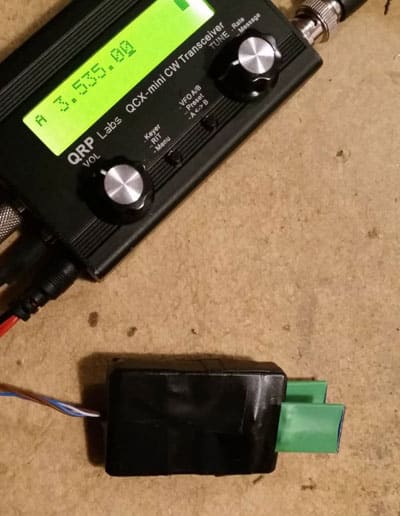 By Paul ZL1AJY
By Paul ZL1AJY
Here’s version 1.00 of my Touch Paddles Using Cheap Capacitance PCB. A very simple circuit drives a couple of signal transistors to the radio CW paddle socket. The power source is via the lead to radio.
It took a few evenings of trial and mostly error to get a repeatable result.
Components and 7805 regulator are inside the taped-up box. The only difference to using a regular key is the switching time, which could be in the order of 20-30 milliseconds. At 20 wpm the paddles are somewhat hit and miss using iambic keying. As an example, the letter K will be sensed as C using Iambic Mode-B. This would not be an issue normally, but after 35 years of using Mode-A or relaxed Mode-B it is hard to alter my keying style. At slower speed, around 15wpm, it’s not too bad, but errors creep in.
The complete paddles weigh only a few grams and are easy to pack. There’s no issue with RF at 100 watts on 80m and 40m, although my antennas are 30 metres or more from the transmitter, so it’s probably not a reliable check for RF immunity.
Tiny paddles seemed a good idea at the time. The snag is having to use them while holding the plastic box with the non-keying hand. In my case this totally destroys the original concept of small light weight hardware in the field. Several commercial units have mounting points to fit popular transceivers such as the KX-2, KX-3 and FT-818, but my paddles look like a non-starter for use with QRP Labs QCX.
I am currently looking into using a PC gaming joystick with a couple buttons as dot and dash.
* If you have an interesting key for this feature, please send me a nice clear photo and a few words describing it.
Quick notes
 Field Days are coming up on 25-26 February. I know some guys who say they don’t take it too seriously – and yet every year they post the top score in the country. Some have even suggested they must be running QRO, although I have seen no evidence to support such a wild accusation. 🙂
Field Days are coming up on 25-26 February. I know some guys who say they don’t take it too seriously – and yet every year they post the top score in the country. Some have even suggested they must be running QRO, although I have seen no evidence to support such a wild accusation. 🙂
Welcome to our 100th newsletter. I am so grateful for the many articles contributed by our net operators, and for our many readers – not just in New Zealand but all over the world.
The SKCC Oceania QRS Saunter will take place on Saturday 18 February, 0000-2359 UTC. If you are looking to make a few slow speed CW contacts this might just be the event for you. Get details.
Storm proves vulnerabilty of phone system
Cyclone Gabrielle has certainly demonstrated the fragility of our telecommunications systems, with thousands of people left unable to access telephone or internet services in the immediate wake of the storm.
In the worst-hit areas, cell sites that remained standing often had no power. With bridges washed out, and highways blocked by ‘slips’, there was sometimes no way to get fuel to generators to power the sites – or anything else that needed electricity.
David ZL2WT, our only operator in the devastated Hawke’s Bay region, has been on holiday in the South Island, but reported to me that his garden shed had been seen floating away. We hope that’s the only damage he sees on his return.
Cyclone-related messages have been heard on 7070 and 3775 kHz (LSB) as well as on the National System (UHF FM).
For updates, see the AREC page on Facebook.
When the immediate danger has passed, I hope NZART will report to us what role amateur radio played in providing communications and what lessons were learned. Clearly, having a radio and an antenna are only part of providing emergency communications. One also needs power, water, food and shelter. A lot to ask for in such an extreme event.
Photo flashback
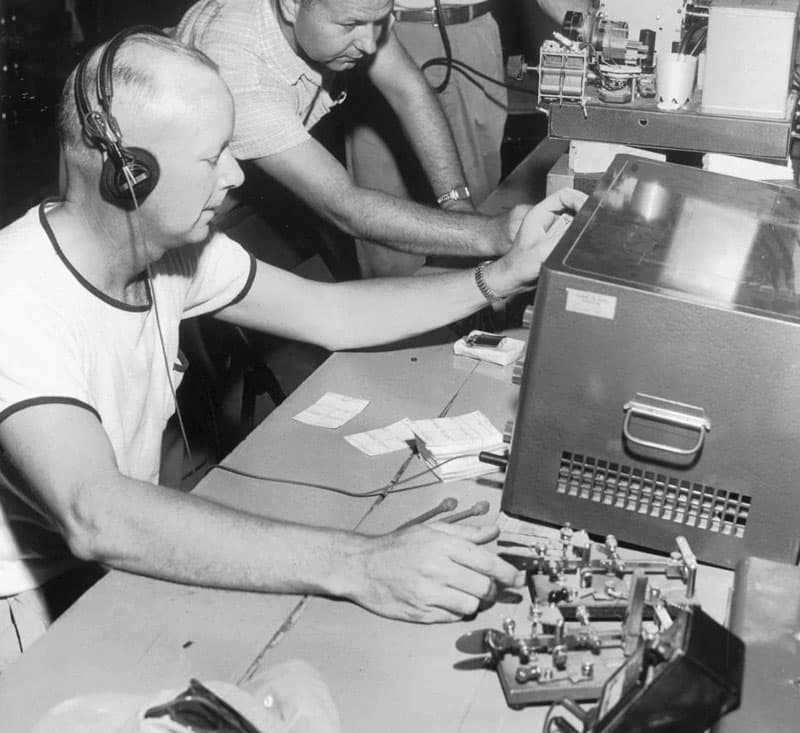
The 1956 ARRL Field Day was clearly a BYOB event in Richmond, Virginia. (Bring Your Own Bug)
Key goes on holiday
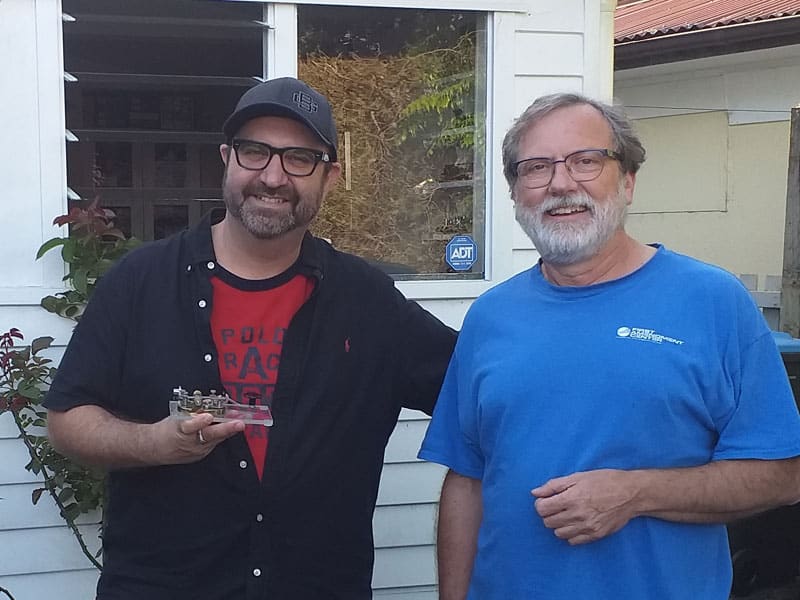
Dave N2JNR (left) and Neil ZL1NZ
It was about 5.30pm on Waitangi Day, 6 February. I was working in my office when an email arrived from someone I didn’t know:
“My name is Dave, N2JNR. I’m in Auckland for the night before flying to the Cook Islands for a few nights. I know this is very last minute, but would you know anyone in Auckland who might be looking to sell a key? I connected with a ham in the Cook Islands but he only does SSB and digital/ft8. He doesn’t own a key. Would love to operate out there if at all possible. Very last minute and it doesn’t help that my flight to the islands is first thing in the AM, though figured I’d reach out to some in the local ham community here.”
A quick look at QRZ.com showed that Dave was a serious CW man, with Begali and Bencher paddles, plus a couple of Vibroplexes, at his home in Los Angeles. I had nothing that nice to offer him, but I did have a JJ-38 straight key that I could donate, if he was interested in operating novice-style.
Within an hour Dave was standing in my driveway where I was teasing him about leaving home without a key. “What on Earth was he thinking?!” We had a quick chat and a look at my shack while his Uber driver turned the car around, and then he was off to catch a few hours rest before his 5am wakeup call and trip to the Cooks. I hope he’ll think of New Zealand whenever he looks at that old key.
See more about the JJ-38 key in the Advertising Archive section of this newsletter.
Another approach to low-cost feedline spacers
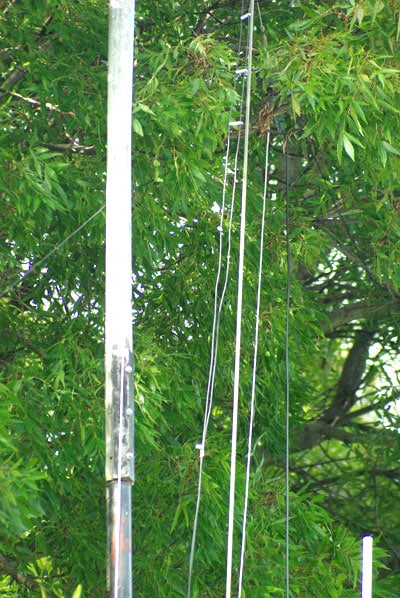 By Gerard ZL2GVA
By Gerard ZL2GVA
When looking up at my open-wire feedline the other week I noticed that it was starting to miss quite a few spreaders (see photo).
According to a note in my logbook, I made the line in October 2020. I used the same system as VK4PN (shown in NZ Net News 89), but instead of 50mm masonry plugs I use 25mm lengths of Ø6mm (Ø4mm inside) pneumatic plastic hose, as this was freely available in the rubbish bin at work!
The line impedance with these spreaders will be around 400-450 Ohms, but as I’m using a 1:4 balun and tuner this doesn’t really matter. The shorter length means I can use just one 3x100mm zip-tie per spreader, passing it though the spreader back and forth.
The old line had cheap white plastic ties (I think it was a flea-market sale bag of 1000 ties for $3 or so), which I knew would not last long in the Marlborough sun, but they exceeded my expectations by holding out for about two and a half years. The new ones are black and should last even longer.
While having the antenna down I inspected the connections to the feeder and they are still all ok (stainless steel screws covered with Vaseline).

Morse challenge
Your challenge is to listen to the Morse in this video and tell me the opening and closing times of the Monday-Friday HF telegraphy service at coast station Norddeich Radio DAN.
Send your answer via radiogram or email to ZL1NZ.
Answer to previous Morse challenge
The correct answer was 9VG25 Radio in Singapore. Correct answers were received from IK4DCT, VK3DRQ, ZL1ANY, ZL1AYN, ZL2GVA, ZL2IR, ZL3TK.
Video: Google introduces Gmail Tap
Did you notice all those beautiful vintage keys in the video? If not, go to 0:36 for another look. And if you’re thinking “this has to be a joke, right?”, I’m sad to say you’re right.
Advertising archive
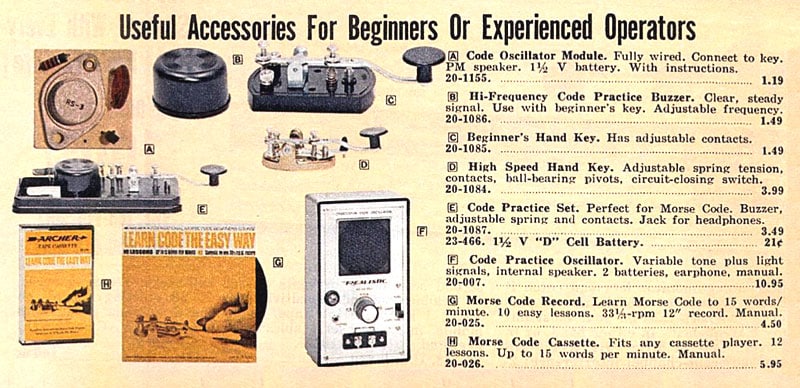
An old Radio Shack catalogue includes a popular key (labelled D) which was also sold by Ameco and other companies. This is the type of key that N2JNR took to Cook Islands. The key resembles a J-38, but with ball bearings. Made in Japan, it was nicknamed the JJ-38.
Suggestions?
If you have suggestions on how to make the NZ Net better, or things you’d like to see covered in these updates, please contact ZL1NZ. You might even like to write something for the newsletter.
Thanks for reading, and I hope to hear you soon on the NZ Net!
—
Neil Sanderson ZL1NZ, Net Manager
New Zealand Net (NZ NET)
3535.0 kHz at 9pm NZT Mon-Fri




